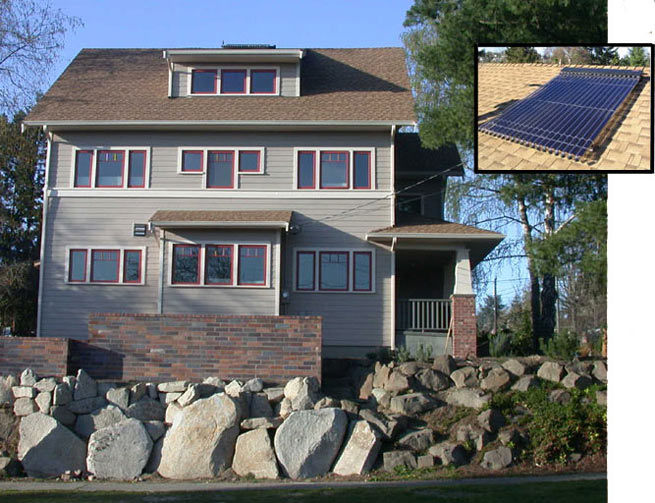What is Green Building? - Energy
The two key energy efficient ideas we used were super-insulation and solar energy. To understand the principles behind these click here.
Super-Insulation
 The idea is to keep the heat in (or out!),
and it's not much more complicated than putting on a coat in the winter.
There are various ways to do this: double 2x4 walls, a 2x4 wall sheathed in
3" of foam board, SIPs, or strawbale walls. Combined with this use R3
(U=.34) double glaze windows, or even better yet use R5 (U=.2) triple glaze
units everywhere you don't what solar gain. The latter are only available
from only a limited number of manufacturers.
The idea is to keep the heat in (or out!),
and it's not much more complicated than putting on a coat in the winter.
There are various ways to do this: double 2x4 walls, a 2x4 wall sheathed in
3" of foam board, SIPs, or strawbale walls. Combined with this use R3
(U=.34) double glaze windows, or even better yet use R5 (U=.2) triple glaze
units everywhere you don't what solar gain. The latter are only available
from only a limited number of manufacturers.
The house should be built a fairly "tight", meaning that it doesn't leak a lot of air. To do this, use spray foam (or equivalent) around all the framing cracks and penetrations before insulating, and then, as an added barrier, consider filling the walls with a dense insulation, such as cellulose or foam, although this step isn't as important. All insulations have some tradeoffs: click here for more detailed info). A housewrap, which could be just tar paper, and rainscreen siding will also act as an air barrier.
There has been some controversy about building "tight" houses, mostly having to do with mold problems and "sick building syndrome". It's important to know that even a tight house leaks will in the range of 30 to 70 cubic feet of air a minute (about 2000 cubic feet an hour), while a typical house probably leaks 2-5 times that amount. When the wind blows or its cold out, or a door or window is opened, or an exhaust fan is used, the air leakage goes up from that. Tights house don't lack in fresh air. The important point is to make sure you eliminate excess indoor moisture, use low toxic building materials and keep toxins out of the house (for background: click here. For example details click here.)
One nice benefit to thick walls, is deep window sills (see photo).
Solar Energy
 Start by finding a location that gets a lot of sunshine, which
in cities pretty much means its on the north side of an E/W street and not on a
north facing slope. The biggest issue in cities in having your sunlight
blocked by other buildings or trees. Sun in the west is so hot in the
summer, that if its not block, then shading is usually desirable.
Start by finding a location that gets a lot of sunshine, which
in cities pretty much means its on the north side of an E/W street and not on a
north facing slope. The biggest issue in cities in having your sunlight
blocked by other buildings or trees. Sun in the west is so hot in the
summer, that if its not block, then shading is usually desirable.
Put the majority of windows on the south side, and then arrange them to have an overhang, so that on June 21st, most of the glass is shaded by the overhang (not the same warmer climates). The easiest way to free solar energy is to have about 7% glass on the south side (to find out what that means, click here.) This won't maximize how much solar energy you use, but it allows you to use solar energy with no additional cost. In cloudy Seattle, doing this reduces your heating requirement by about 25%.
Additional energy can be achieved using solar hot water collectors, on the roof or elsewhere. For an example of this click here...
Other issues
It is fairly easy to get quite energy efficient appliances, and although the best ones tend to cost more, good ones can be had at reasonable prices. In 2004 we found a top rated refrigerator at Sears, and ones that are pretty close at many appliances places (for ratings see www.energystar.gov). The most efficient refrigerators also tend to be lower cost, since they have fewer features.
In dishwasher and washing machines, the more efficient models tend to be the more expensive, but in this case, they also have additional features.
We're sold on PEX plumbing, using the "home run" configuration. While you should still try to locate plumbing fixtures near the hot water heater, the skinny PEX pipes deliver hot water fast, saving both water and energy (heat lost from the pipe after you turn the water off). Click here for a construction example.
Daylighting in homes isn't that hard: put windows on two walls in most rooms, and avoid having oversized windows. In north facing room, skylights can be used to great advantage. Divide electrical lighting into ambient lighting (not super bright) and task lighting (bright, but only in a small area), rather than make the entire room bright enough to read in. Compact fluorescent bulbs are much improved in both color and longevity, and new innovative bulbs are expected to hit the market by 2010.
Computers are huge electric hogs, although laptops are much better, especially if they hibernate when not in use. Put plug strips on TVs and other devices with remotes, to keep them from using power when they're not on (they use power sitting there waiting for you to press "on" on the remote control!).
